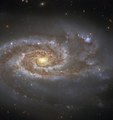File:NGC5861 - HST - Potw2019a.tif

Size of this JPG preview of this TIF file: 563 × 599 pixels. Other resolutions: 225 × 240 pixels | 451 × 480 pixels | 721 × 768 pixels | 962 × 1,024 pixels | 1,924 × 2,048 pixels | 3,360 × 3,577 pixels.
Original file (3,360 × 3,577 pixels, file size: 68.8 MB, MIME type: image/tiff)
File history
Click on a date/time to view the file as it appeared at that time.
| Date/Time | Thumbnail | Dimensions | User | Comment | |
|---|---|---|---|---|---|
| current | 08:56, 11 May 2020 |  | 3,360 × 3,577 (68.8 MB) | Fabian RRRR | == {{int:filedesc}} == {{Information |Description='''Two Supernovae, One Galaxy Approximately 85 million light-years from Earth, in the constellation of Libra, is the beautiful galaxy NGC 5861, captured here by the NASA/ESA Hubble Space Telescope. NGC 5861 is an intermediate spiral galaxy. Astronomers classify most galaxies by their morphology. For example, the Milky Way galaxy is a barred spiral galaxy. An intermediate spiral galaxy has a shape lying in between that of a barred spiral ga... |
File usage
The following pages on the English Wikipedia use this file (pages on other projects are not listed):
Global file usage
The following other wikis use this file:


